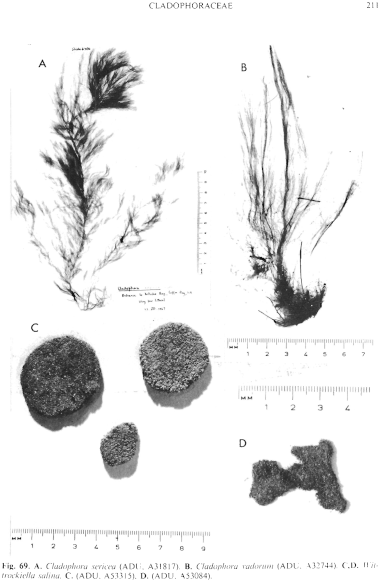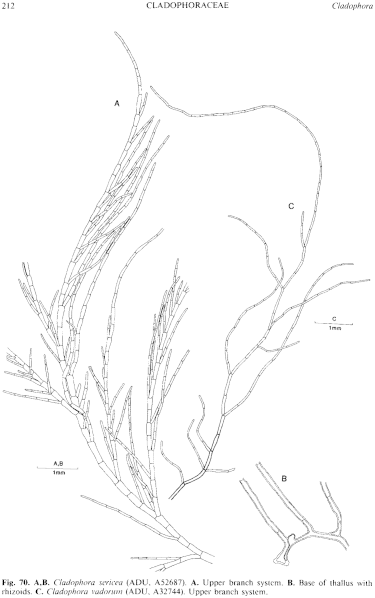|
|
|
|
|
|||||||||||
|
Electronic Flora of South Australia Species Fact Sheet
Phylum Chlorophyta – Order Cladophorales – Family Cladophoraceae
Selected citations: van den Hoek 1963: 141, figs 430–432, 441–454, 456–469.
Thallus (Fig. 69B) medium to light green, 5–30 cm high, flexuous, not tufted, attached by rhizoids from cells in the basal region; occasionally as floating masses; a species from sheltered areas. Main axes pseudodichotomous, ending in branch systems with a vaguely acropetal to irregular organisation with patent branches quite widely spaced (Fig. 70C). Growth by divisions of conspicuous apical cells and by intercalary divisions, very feebly acropetal; parent cells usually with only a single lateral, occasionally two, usually at an obtuse angle (more than 45°); basal cross wall of laterals steeply inclined to oblique, becoming almost horizontal below.
Apical cells cylindrical with rounded to tapering tips, 30–50 µm in diameter and L/B 7–13; ultimate branch cells 40–65 µm in diameter and L/B 5–10; main lower thallus cells 65–120 µm in diameter and L/B 3–10; ratio of lower cell to apical cell diameters 2.5–4; cell walls thin (1–2 µm) in upper cells, becoming 10–20 jim thick in oldest parts.
Type from Goteborg, Sweden. Isotype in L, 937,155 . . . 109.
Distribution: Scattered protected and estuarine localities along tropical to warm temperate Atlantic coasts of Europe, West Africa and America (van den Hoek 1982, p. 160, map 19).
Known in southern Australia from one record: Crawfish Rock, Westernport Bay, Vic., pools, just sublittoral ( Watson, 15.ix.1968; ADU, A32744). This is a 6 cm high attached plant whose characters are within the range of Cl. vadorum.
Taxonomic notes: Cl. vadorum shows some similarity to Cl. sericea and calm water forms of Cl. vagabunda. It differs from Cl. sericea by its longer cylindrical apical cells, and by its much scarcer ramification with spaced patent laterals; it differs from Cl. vagabunda by being thicker, by lacking distinct acropetal fascicles, and by its more sparse branching.
References:
KÜTZING, F.T. (1849). Species Algarum. (Leipzig.)
VAN DEN HOEK, C. (1963). Revision of the European species of Cladophora. (Brill: Leiden.)
VAN DEN HOEK, C. (1982). A taxonomic revision of the American species of Cladophora (Chlorophyceae) in the North Atlantic Ocean and their geographic distribution. Verh. k. Ned. Akad. Wet. Afd. Natuurkd. Tweede Reeks, Part 78.
The Marine Benthic Flora of Southern Australia Part I complete list of references.
Publication:
Womersley, H.B.S. (31 May, 1984)
The Marine Benthic Flora of Southern Australia
Part I
©Board of the Botanic Gardens and State Herbarium, Government of South Australia
Illustrations in Womersley Part I, 1984: FIGS 69B, 70C.

Figure 69 enlarge
Fig. 69, A. Cladophora sericea (ADU, A31817). B. Cladophora vadorum (ADU. A32744). C,D. Wittrockiella salina, C. (ADU, A53315), D. (ADU, A53084).

Figure 70 enlarge
Fig. 70. A,B. Cladophora sericea (ADU, A52687). A. Upper branch system. B. Base of thallus with rhizoids. C. Cladophora vadorum (ADU, A32744). Upper branch system.

|
Email Contact: State Herbarium of South Australia |

|